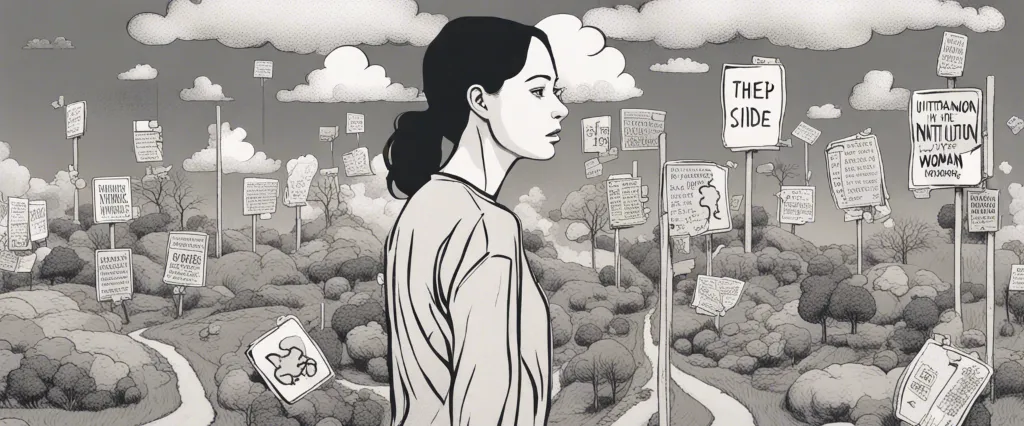In her enlightening book, “Don’t Overthink It,” author Anne Bogel offers a refreshing approach to overcoming analysis paralysis and reclaiming clarity in our daily lives. Bogel, a well-known podcaster, blogger, and author, draws upon her personal experiences and extensive research to provide practical strategies for breaking free from the shackles of overthinking. As a trusted voice in the realm of intentional living, Bogel guides readers towards a more simplified and joyful mindset, empowering them to make confident decisions without getting stuck in endless cycles of rumination.
Chapter 1: The Perils of Overthinking
Chapter 1: The Perils of Overthinking of the book “Don’t Overthink It” by Anne Bogel explores the negative consequences of overthinking and the importance of overcoming this habit in our lives. Bogel begins by discussing how overthinking can consume our thoughts, leading to stress, anxiety, and the inability to make decisions.
The chapter examines three major perils of overthinking. Firstly, it drains our mental and emotional energy. Bogel highlights how overthinking can be exhausting, leaving us mentally fatigued and less productive. She emphasizes the importance of conserving our mental energy by reducing overthinking.
Secondly, overthinking hampers our decision-making abilities. Bogel explains how overanalysing every detail can lead to decision paralysis, preventing us from taking any action at all. She notes that by recognizing this tendency, we can learn to make more efficient decisions and trust our instincts.
Lastly, overthinking robs us of the present moment. The constant ruminating and excessive worry prevent us from fully experiencing and enjoying our lives. Bogel encourages readers to be more present and aware, focusing on the here and now rather than dwelling on past events or future uncertainties.
The chapter also provides practical advice for combating overthinking, such as setting aside dedicated thinking time, implementing mindfulness techniques, and challenging negative thought patterns through journaling. Additionally, Bogel emphasizes the importance of self-compassion and developing a growth mindset, acknowledging that progress in overcoming overthinking takes time and effort.
In conclusion, Chapter 1 of “Don’t Overthink It” sheds light on the detrimental effects of overthinking and highlights the need to break free from this habit. By understanding the perils of overthinking, readers can begin to implement practical strategies to cultivate a more present-focused, decisive, and peaceful mindset.
Chapter 2: Traps of Analysis and Decision-Making
Chapter 2 of “Don’t Overthink It” by Anne Bogel, titled “Traps of Analysis and Decision-Making,” delves into the common struggles and traps we often encounter when faced with making decisions, and provides practical strategies to overcome these obstacles.
Bogel starts by emphasizing the negative consequences of overthinking, which can lead to decision paralysis, wasted time and energy, and ultimately, a failure to take action. She introduces the concept of analysis paralysis, where we get stuck in a cycle of over-analyzing and over-complicating decisions, often driven by fear of making the wrong choice.
The author then outlines three common traps that hinder our decision-making process. The first is the “ego-trap,” where we become preoccupied with what others will think about us and our choices. Bogel encourages us to shift our focus to our own values, priorities, and goals, rather than trying to meet others’ expectations.
The second trap is the “seagull trap,” referencing the overwhelming amount of information available today. With an abundance of options and opinions, Bogel provides practical tips to navigate through the noise and identify the most important factors to consider, while setting boundaries on excessive information gathering.
Lastly, the “time-trap” highlights our tendency to postpone decisions unnecessarily due to the fear of making the wrong choice. Bogel suggests using a “good enough” mindset, reminding readers that not every decision needs to be perfect, and encourages embracing an attitude of learning from mistakes rather than avoiding them.
In conclusion, Chapter 2 of “Don’t Overthink It” sheds light on the traps individuals frequently fall into when making decisions. Through practical strategies, Bogel empowers readers to recognize and overcome these hindrances, enabling more efficient and confident decision-making while maintaining perspective and personal values.
Chapter 3: Exploring Emotions and Intuition
Chapter 3 of “Don’t Overthink It” by Anne Bogel delves into the exploration of emotions and intuition. Bogel begins the chapter by emphasizing the significance of understanding and embracing our emotions rather than suppressing or ignoring them. She highlights how our emotions can serve as valuable information that can guide us towards making better decisions.
The author encourages readers to identify their primary emotions by practicing emotional labeling. By naming our emotions accurately, we gain clarity and can respond appropriately to them. This practice helps us avoid overthinking and instead trust our intuition. Bogel stresses the importance of listening to our gut feelings and understanding the message behind them. She advises against dismissing intuition as mere irrational thoughts, as it often holds deep wisdom and insights.
Bogel explains that intuition is a valuable tool that can aid us in decision-making processes. By recognizing and embracing our intuitive thoughts, we can make better choices without the burden of overthinking. However, she also cautions against mindlessly following intuition without considering logic and reason. A balance between intuition and analytical thinking must be achieved for effective decision-making.
Throughout the chapter, Bogel shares practical tips for nurturing and utilizing our emotions and intuition. These include journaling to gain emotional clarity, seeking outside perspectives, and using visualization techniques. She recommends engaging in activities that foster self-awareness and emotional well-being, such as practicing mindfulness and meditation.
In summary, Chapter 3 of “Don’t Overthink It” encourages readers to acknowledge and understand their emotions, as well as trust their intuition. By embracing and harnessing these inner tools, we can make decisions with greater confidence and clarity, ultimately leading to a more fulfilling and intentional life.
Chapter 4: Liberating Your Mind

Chapter 4: Liberating Your Mind of the book “Don’t Overthink It” by Anne Bogel focuses on strategies and practices to free your mind from the burdens of overthinking. Bogel explores the detrimental effects of overthinking and provides practical advice on how to overcome it.
The chapter begins by emphasizing the importance of decluttering our minds. Our thoughts can become cluttered with worries, doubts, and excessive analysis, preventing us from making decisions or taking action. Bogel suggests that acknowledging and reframing our thoughts can help us regain control and clarity.
One of the key strategies Bogel recommends is practicing mindfulness. By being fully present in the moment and letting go of distracting thoughts, we can reduce the mental clutter that often leads to overthinking. She suggests simple techniques like deep breathing, grounding oneself in the physical world, and paying attention to the senses to anchor our minds in the present.
Another aspect Bogel highlights is the importance of setting healthy boundaries. Overthinking can often stem from a fear of disappointing others or not meeting perceived expectations. By learning to say no, setting limits, and prioritizing our own well-being, we can protect our mental space and avoid becoming overwhelmed.
Bogel also stresses the importance of self-compassion and self-care. She encourages readers to acknowledge their limitations and embrace imperfections. Setting realistic expectations for ourselves can prevent overthinking as we learn to accept our efforts and achievements.
In a world that often glorifies busyness, Bogel reminds readers to pause and give themselves permission to rest. Cultivating quiet and restorative activities, such as meditation, journaling, or spending time in nature, can help quiet the overactive mind.
Overall, Chapter 4 of “Don’t Overthink It” provides valuable insights and practical guidance on how to liberate our minds from the trap of overthinking. By practicing mindfulness, setting boundaries, fostering self-compassion, and prioritizing rest, we can create mental clarity and lead a more fulfilling and intentional life.
Chapter 5: Letting Go of Perfectionism
Chapter 5 of “Don’t Overthink It” by Anne Bogel is titled “Letting Go of Perfectionism.” In this chapter, Bogel explores the detrimental effects of perfectionism and provides practical strategies to overcome it.
Bogel begins by acknowledging that perfectionism can often hinder productivity and creativity. She explains that the pursuit of perfection can lead to indecision, procrastination, and fear of failure. To counteract these tendencies, she highlights the importance of embracing imperfection and reframing failure as an opportunity for growth and learning.
One of the key strategies Bogel suggests for letting go of perfectionism is setting realistic expectations. She advises readers to focus on progress rather than striving for flawless outcomes. By embracing the concept of “good enough,” individuals can alleviate the pressure they place on themselves and find freedom in imperfection.
Another technique she recommends is to simplify decisions. Bogel emphasizes the benefits of limiting choices and avoiding excessive research or overthinking. She encourages readers to trust their intuition and make decisions based on their core values rather than seeking perfection.
Additionally, Bogel suggests practicing self-compassion as a way to combat perfectionism. She encourages readers to treat themselves with grace and forgiveness, acknowledging that mistakes are inevitable and part of the learning process.
Ultimately, Bogel reminds readers that perfectionism is unattainable and can be a hindrance to personal growth and happiness. By letting go of perfection and embracing imperfection, individuals can experience greater freedom, increased productivity, and a more fulfilled life.
Chapter 6: Cultivating Positive Thinking
Chapter 6: Cultivating Positive Thinking of the book “Don’t Overthink It” by Anne Bogel discusses the importance of positive thinking and offers practical strategies to cultivate a positive mindset despite the challenges of overthinking.
Bogel explains that overthinking tends to lead to negative thoughts and creates a spiral of pessimism. However, shifting towards positive thinking can benefit us emotionally, mentally, and even physically. Positive thinking helps reduce stress, improves productivity, enhances relationships, and contributes to overall well-being.
To foster positive thinking, Bogel suggests various strategies. Firstly, she emphasizes the significance of gratitude. Being grateful for the small things in life helps shift our focus from negative thoughts to positive ones. Bogel encourages readers to keep a gratitude journal or practice regular gratitude meditation to cultivate a grateful mindset.
Another technique to cultivate positive thinking is reframing. Reframing involves consciously changing the way we perceive a situation, focusing on the positive aspects instead of dwelling on the negative. Bogel acknowledges that this requires practice and offers practical tips such as identifying negative thinking patterns and replacing them with positive alternatives.
Bogel also highlights the power of positive self-talk. Our internal dialogue greatly influences our mindset and emotions. By intentionally choosing positive and encouraging words when speaking to ourselves, we can boost our self-esteem and encourage a more positive outlook on life.
In addition, Bogel suggests the importance of surrounding ourselves with positive influences. This includes seeking out positive and supportive people who can help us maintain a positive mindset. She also recommends consuming uplifting media and avoiding negativity that can drag us down.
In conclusion, Chapter 6 of “Don’t Overthink It” emphasizes the significance of positive thinking and provides practical strategies to cultivate such a mindset. By incorporating gratitude, reframing, positive self-talk, and surrounding ourselves with positive influences, we can shift our perspective and experience the numerous benefits of positive thinking.
Chapter 7: Simplifying and Optimizing
Chapter 7 of “Don’t Overthink It” by Anne Bogel focuses on simplifying and optimizing various aspects of our lives to reduce stress and increase overall well-being. Bogel emphasizes the importance of creating intentional habits, managing time effectively, and streamlining our environments.
Bogel begins by discussing the impact of decision fatigue, explaining how constantly making choices can drain our mental energy. To combat this, she suggests simplifying daily routines and automating decisions whenever possible. By establishing a few key habits, such as planning meals or laying out clothes in advance, we can create a sense of predictability and reduce decision-making stress.
Next, Bogel explores the concept of time management, advising readers to assess their priorities and establish boundaries to prevent overwhelm. This involves learning to say no, delegating tasks, and setting realistic expectations for ourselves. By being mindful of how we spend our time, we can optimize productivity and make room for activities that bring us joy and fulfillment.
Bogel also encourages readers to declutter and organize their physical spaces, as a cluttered environment can contribute to mental clutter. She provides practical tips for simplifying belongings, such as using the “one in, one out” rule or creating designated spaces for commonly used items. Bogel explains how simplifying our physical surroundings can lead to less stress and promote a greater sense of calm and focus.
In conclusion, Chapter 7 of “Don’t Overthink It” emphasizes the importance of simplifying and optimizing different aspects of our lives. By developing intentional habits, managing time effectively, and streamlining our environments, we can reduce decision fatigue, prevent overwhelm, and create a more peaceful and fulfilling lifestyle.

Chapter 8: Living in the Present
Chapter 8 of “Don’t Overthink It” by Anne Bogel explores the concept of living in the present and offers strategies to help readers embrace and fully experience the current moment. Bogel begins by acknowledging that overthinking often prevents us from fully engaging with our lives, causing anxiety, stress, and a sense of unease. She introduces the idea of present-mindedness as a powerful tool to combat overthinking and invites readers to shift their focus to the present.
The chapter delves into various techniques aimed at grounding individuals in the present moment. One of the strategies discussed is mindfulness, which involves intentionally paying attention to one’s thoughts, emotions, and surroundings without judgment. Bogel emphasizes the importance of cultivating a nonjudgmental attitude toward one’s thoughts and simply observing them as they arise. She suggests incorporating mindfulness into daily routines, such as during meals or while engaging in mundane tasks, to foster a greater sense of presence.
Bogel also addresses the role of gratitude in living in the present. She highlights the importance of appreciating the present and finding joy in small moments. By focusing on what one is grateful for, individuals can shift their mindset and develop a deeper sense of contentment. Additionally, she suggests the practice of savoring, which involves fully immersing oneself in positive experiences and relishing the details.
The chapter concludes by highlighting the value of accepting imperfections and finding beauty in the imperfect moments of life. Bogel encourages readers to let go of the need for control and embrace the spontaneity and messiness inherent in living. By doing so, she suggests, individuals can find freedom from overthinking and unlock the full richness of the present moment.
After Reading
In “Don’t Overthink It” by Anne Bogel, readers are provided with practical strategies to overcome the overwhelming burden of excessive thinking. Bogel emphasizes the importance of recognizing overthinking patterns and offers actionable tips on how to break free from them. By approaching decision-making, perfectionism, and worry with a more intentional mindset, readers can gain a sense of clarity, peace, and productivity in their lives. Bogel’s insightful guidance encourages readers to embrace simplicity, trust their instincts, and let go of unnecessary mental burdens. Offering a simple yet effective roadmap to a more mindful existence, “Don’t Overthink It” serves as a valuable resource for anyone seeking to cultivate a more balanced and peaceful mind.
1. “The Art of Simple Living: 100 Daily Practices from a Japanese Zen Monk for a Lifetime of Calm and Joy” by Shunmyo Masuno
This book offers practical advice and mindfulness techniques to declutter the mind and find peace in simplicity. Like “Don’t Overthink It,” it encourages readers to let go of unnecessary worries and focus on the present moment.
2. The Subtle Art of Not Giving a F*ck: A Counterintuitive Approach to Living a Good Life” by Mark Manson
Similar to “Don’t Overthink It,” this book presents a refreshing perspective on finding happiness by embracing imperfections and making deliberate decisions. Mark Manson encourages readers to stop overanalyzing and start living a more authentic, intentional life.
3. “Mindset: The New Psychology of Success” by Carol S. Dweck
With a strong emphasis on personal growth, Carol Dweck’s book explores the concept of mindset and how it can impact our success. Like Anne Bogel, Dweck encourages readers to adopt a growth mindset, let go of fixed beliefs, and embrace challenges to maximize their potential.
4. “Overwhelmed: Work, Love, and Play When No One Has the Time” by Brigid Schulte
In this eye-opening book, Brigid Schulte examines the increasing busyness and overwhelm of modern life. Similar to “Don’t Overthink It,” it explores ways to regain control over our time, manage stress, and prioritizes what truly matters.
5. The Power of Now: A Guide to Spiritual Enlightenment” by Eckhart Tolle
For those seeking a deeper understanding of the present moment and finding inner peace, this book is a must-read. Echoing themes from “Don’t Overthink It,” Tolle encourages readers to free themselves from the incessant thoughts of the past and future, and embrace the transformative power of living in the now.




